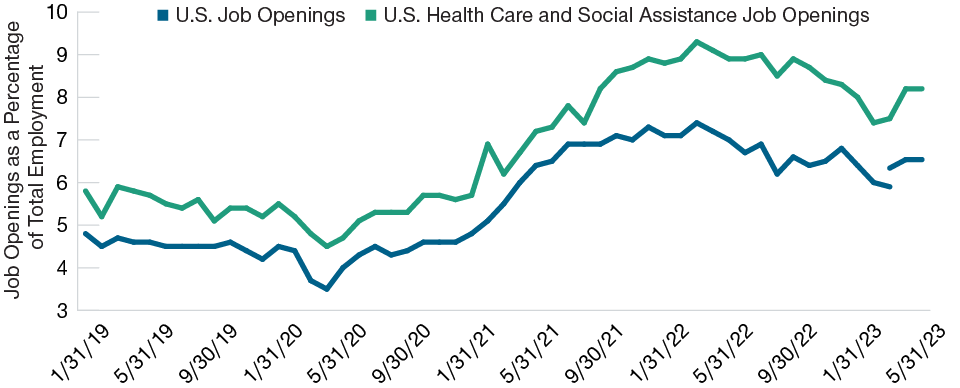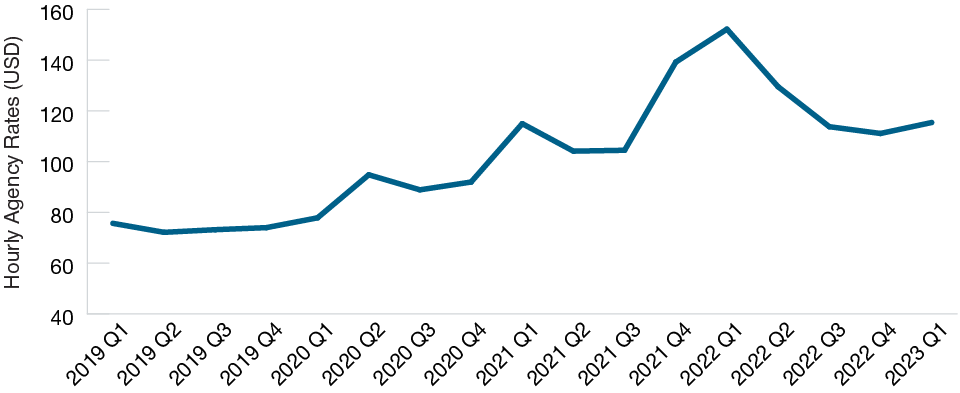July 2023 / INVESTMENT INSIGHTS
Post-Pandemic Trends Support Credit Quality in Health Care
Collaboration across health care industries reveals credit trends
Key Insights
- While the pandemic introduced unprecedented volatility into the health care space, we are cautiously optimistic that pressures driven by COVID have peaked.
- We expect the fundamental credit quality of health care providers and medical technology companies to gradually improve.
- Health insurers increased rates after the onset of the pandemic prior to renegotiating reimbursement rates, so we think their credit profiles will be stable.
While COVID introduced unprecedented volatility into the health care space, we are cautiously optimistic that pressures driven by COVID have peaked, and we expect the fundamental credit quality of most health care providers and medical technology companies to gradually improve. Conversely, health insurers benefited from the ability to increase rates after the onset of the pandemic prior to renegotiating reimbursement rates with providers, so we anticipate that the credit profiles of health insurers will remain stable.
Pandemic Headwinds for Hospitals
COVID presented many headwinds for hospitals; some of those, such as the temporary suspension of elective procedures, were short-lived. Others, such as elevated labor costs, continue to linger to varying degrees. Various federal and state COVID relief funding initiatives offset much of the lost revenue from the suspension of elective procedures, but most of those funds have now been exhausted.
Nurse burnout, early retirements, and higher-paying agencies that specialize in providing health care labor support turbocharged a nursing shortage that existed prior to the pandemic, pushing hospital labor costs even higher. Figure 1 illustrates how U.S. health care and social assistance job vacancies increased even more than vacancies in the broad job market during the pandemic.1
Health Care Vacancies Surged in Pandemic
(Fig. 1) Job openings as a percentage of total employment

As of May 31, 2023.
Source: Department of Labor.
Health care systems responded by boosting pay to attract and retain talent, increasing overtime pay to fill staffing gaps, and relying on expensive agency labor. Figure 2 shows the material escalation of hourly agency rates relative to pre-pandemic levels. Although rates vary by regional market, broadly speaking, the hourly agency rate was roughly USD 75 before the pandemic, peaked at approximately USD 150 during the omicron surge, and moderated to around USD 110 in the first quarter of 2023.2
Hourly Agency Labor Rates Still High
(Fig. 2) But agency costs are well below post-pandemic peak

As of March 31, 2023.
Sources: AMN Healthcare Services, Inc., T. Rowe Price estimates
Suspension of Elective Procedures Weighed on Medical Technology Firms
In addition to challenging health care providers, the suspension of elective procedures and the intensified nursing shortage negatively impacted medical technology companies. Staffing shortages prevented providers from operating at full capacity, let alone recapturing the procedures that had been deferred during the acute phase of the pandemic. Procedure volumes—and therefore demand for medical products—remained stubbornly below pre-pandemic levels through 2021 and most of 2022, creating a headwind for medical technology companies.
Download the full insight here:(PDF)
IMPORTANT INFORMATION
This material is being furnished for general informational and/or marketing purposes only. The material does not constitute or undertake to give advice of any nature, including fiduciary investment advice, nor is it intended to serve as the primary basis for an investment decision. Prospective investors are recommended to seek independent legal, financial and tax advice before making any investment decision. T. Rowe Price group of companies including T. Rowe Price Associates, Inc. and/or its affiliates receive revenue from T. Rowe Price investment products and services. Past performance is not a reliable indicator of future performance. The value of an investment and any income from it can go down as well as up. Investors may get back less than the amount invested.
The material does not constitute a distribution, an offer, an invitation, a personal or general recommendation or solicitation to sell or buy any securities in any jurisdiction or to conduct any particular investment activity. The material has not been reviewed by any regulatory authority in any jurisdiction.
Information and opinions presented have been obtained or derived from sources believed to be reliable and current; however, we cannot guarantee the sources' accuracy or completeness. There is no guarantee that any forecasts made will come to pass. The views contained herein are as of the date noted on the material and are subject to change without notice; these views may differ from those of other T. Rowe Price group companies and/or associates. Under no circumstances should the material, in whole or in part, be copied or redistributed without consent from T. Rowe Price.
The material is not intended for use by persons in jurisdictions which prohibit or restrict the distribution of the material and in certain countries the material is provided upon specific request.
It is not intended for distribution to retail investors in any jurisdiction.



